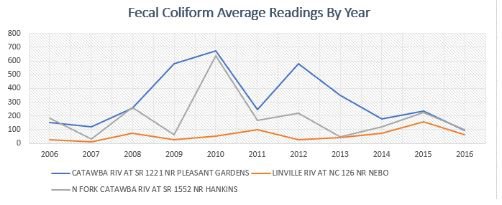Fecal Coliform
The presence of Fecal Coliform in the water is an indicator that the water has been in contact with the feces of warm blooded animals (cows, people, horses, dogs, beavers, muskrats, otters etc.). While Fecal Coliform is not in itself dangerous, a very high presence of Fecal Coliform could be an indicator of a higher presence of more dangerous bacteria like E coli. Fecal Coliform is measured as number of colonies per 100ml. The EPA recommends average results over time for a swimming beach to be under 200 colonies per 100ml (and no more than 10% of samples in excess of 400). The recommendation for drinking water is set at 0 colonies per 100ml. LJEA has not done extensive surveys of Fecal Coliform in the past, however, recent flood events have reminded us of the “first flush effect” and the potential impacts of the farms and septic systems upstream. This prompted LJEA to look at the historical average measures of Fecal Coliform that NCDEQ has taken in the Catawba, North Fork and Linville Rivers over the last 16 years. (See Figure 18). In the chart below, there are spikes in years the area had major rain events which “flushed” farmers’ fields and septic drain fields, etc. NC DEQ takes samples during those events which explains some of those anomalies. While some of the spikes observed in the graph are alarming, taking into account the amount of farmland upstream in the Catawba and North Fork, there is not a need for immediate concern regarding these numbers. Measurements taken in Lake James itself rarely exceed 10 colonies per 100ml. Fecal Coliform colonies degrade over time, degrade with exposure to sunlight, and attach themselves to solids that settle out of the water column in lakes (which explains some of the differences between the readings in the rivers versus Lake James).

Figure 18. Fecal Coliform average measures by year by NCDEQ represented in colonies per 100ml
In participation with the Catawba Riverkeeper’s Water Watcher Program, one of LJEA’s Directors, Dr. Jim Darsie, began Fecal Coliform testing on Lake James in 2018. In his testing of ten sites (primarily on the Burke County side of the lake) he found zero colonies with the exception of only one location where 1 colony per 100ml was found. LJEA plans to expand this testing in our program over the coming months. This provides an excellent opportunity for our members to contribute to our cause by participating in this testing.